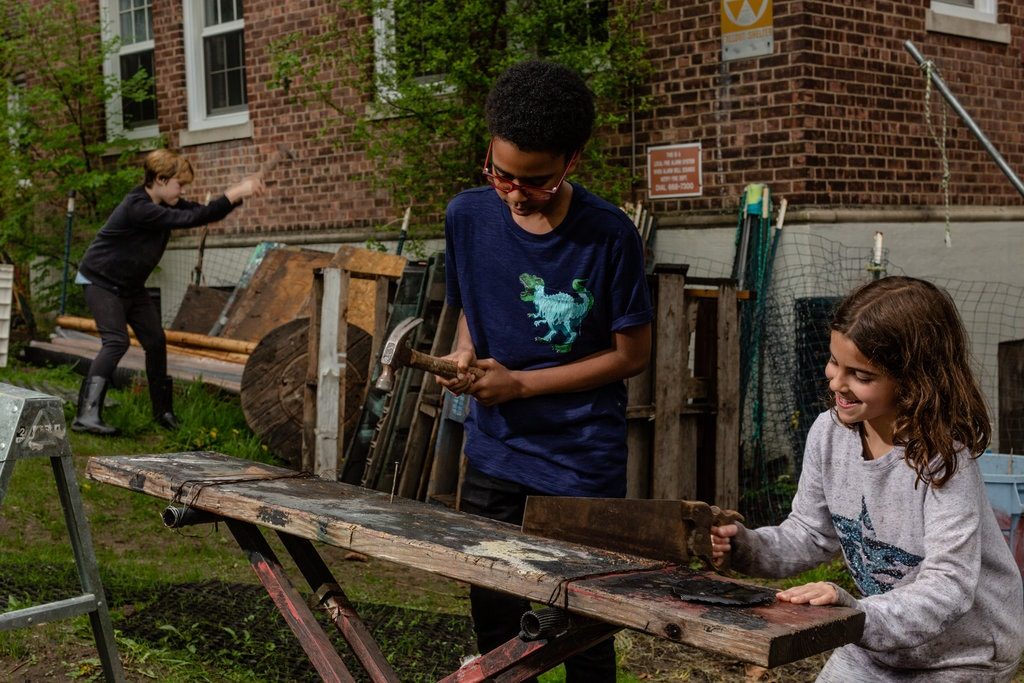Making Playgrounds a Little More Dangerous
A different kind of of playground that challenges what we are used to. Having a safe playground doesn’t necessarily mean it has to be boring. “[E]ngaging in risk is actually very important in preventing injuries.” Have you ever tried anything similar?
“Oh my God, this is going to be amazing,” a preadolescent wearing a gray hoodie exclaimed as he dashed in to The Yard, a 50,000-square-foot adventure playground on Governors Island in New York Harbor.
The Yard, for kids 6 through 13, lacks the usual monkey bars, slides and swings. It is, however, well-stocked with dismembered store mannequins, wooden packing crates, tires, mattresses, an old piano and assorted other detritus of the modern world.
There were a few rules: no iPads or electronic devices, no flip flops and no adults. The painted wooden gate is low to discourage adults from inadvertently wandering in.
Despite a steady rain on Saturday, the opening day for the season, The Yard was a hive of activity. Joey Gunderson, 11, and his crew were attempting — not altogether successfully — to nail together wooden boards and plastic sheeting to construct a ramshackle “house.”
“Playgrounds have everything already built,” Joey explained, “but it’s funner to build whatever you want.”
Nearby, Matheo Torre Bliss, a lanky youth from Manhattan, and a confederate were smashing a keyboard with a hammer, removing the conical speaker and computer chips. Others were digging holes in the mud, scaling a 15-foot steel platform, sawing away at planks and hacking at a signboard with a crowbar.
There were a few rules: no iPads or electronic devices, no flip flops, and no adults.CreditChristopher Lee for The New York Times“Sometimes parents hover by the fence and watch their kids like animals in a zoo,” said Rebecca Faulkner, the executive director of play:groundNYC, the nonprofit that runs The Yard, which opened in 2016. “I tell them, ‘You don’t need to worry, you don’t need to tell them what to do. Just sit back and relax.’”
Children are better at figuring out how to have fun than many adults who build playgrounds for them, Ms. Faulkner said. And they can also figure out how to play safely — even in a place that looks more like a junkyard than a playground.
“We’ve had our share of bruises and scrapes,” she said. “But we’ve never had a serious injury.”
Joey’s father, Christopher Gunderson, a sociology professor at Howard University, watched the action with other parents from a lawn chair outside the playground. “Kids grow up in these really controlled environments,” he said. “This is a place where they can run wild.”
“Play nowadays is totally structured,” Joey’s grandfather, Fred Klonsky, a retired elementary school teacher, chimed in. “They play organized sports supervised by adults, even their disputes are settled by adults. Kids used to work all that stuff out themselves.”
The Danish landscape architect Carl Theodor Sorensen was bothered by the same trends over 70 years ago. He noticed that children in Copenhagen during World War II preferred to play in abandoned lots and construction sites than on the well-appointed asphalt playgrounds that had been built for them.
It may be an uphill battle. There is a widespread belief that time spent on electronic devices is the major reason that children are spending more time indoors. But outdoor play has been declining for decades.
“I don’t buy the argument that the screens are keeping the kids from the playgrounds,” said Susan Solomon, an architectural historian and the author of “American Playgrounds.” “If the playgrounds were better, kids would be there. Better playgrounds would definitely give screens a run for their money.”
The need for better playgrounds was the subject of a report published in late April by Scott Stringer, the New York City comptroller. The report characterized large swaths of the city as “playground deserts” and called for the creation of 200 new playgrounds in underserved neighborhoods in the next five years.
“The Yard is an oasis in the desert,” Ms. Faulkner said. “We’ll be lobbying that some of those new playgrounds should be adventure playgrounds, which are cheap to build and safe to play in.”




Social Networks